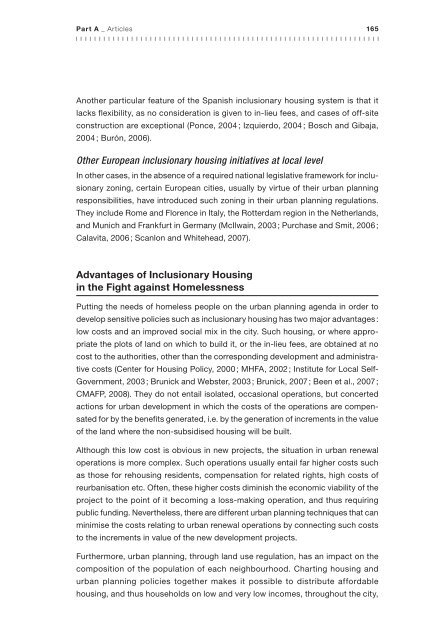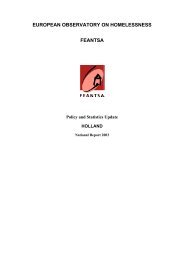Part A - Feantsa - Horus
Part A - Feantsa - Horus
Part A - Feantsa - Horus
You also want an ePaper? Increase the reach of your titles
YUMPU automatically turns print PDFs into web optimized ePapers that Google loves.
<strong>Part</strong> A _ Articles<br />
165<br />
Another particular feature of the Spanish inclusionary housing system is that it<br />
lacks flexibility, as no consideration is given to in-lieu fees, and cases of off-site<br />
construction are exceptional (Ponce, 2004 ; Izquierdo, 2004 ; Bosch and Gibaja,<br />
2004 ; Burón, 2006).<br />
Other European inclusionary housing initiatives at local level<br />
In other cases, in the absence of a required national legislative framework for inclusionary<br />
zoning, certain European cities, usually by virtue of their urban planning<br />
responsibilities, have introduced such zoning in their urban planning regulations.<br />
They include Rome and Florence in Italy, the Rotterdam region in the Netherlands,<br />
and Munich and Frankfurt in Germany (McIlwain, 2003 ; Purchase and Smit, 2006 ;<br />
Calavita, 2006 ; Scanlon and Whitehead, 2007).<br />
Advantages of Inclusionary Housing<br />
in the Fight against Homelessness<br />
Putting the needs of homeless people on the urban planning agenda in order to<br />
develop sensitive policies such as inclusionary housing has two major advantages :<br />
low costs and an improved social mix in the city. Such housing, or where appropriate<br />
the plots of land on which to build it, or the in-lieu fees, are obtained at no<br />
cost to the authorities, other than the corresponding development and administrative<br />
costs (Center for Housing Policy, 2000 ; MHFA, 2002 ; Institute for Local Self-<br />
Government, 2003 ; Brunick and Webster, 2003 ; Brunick, 2007 ; Been et al., 2007 ;<br />
CMAFP, 2008). They do not entail isolated, occasional operations, but concerted<br />
actions for urban development in which the costs of the operations are compensated<br />
for by the benefits generated, i.e. by the generation of increments in the value<br />
of the land where the non-subsidised housing will be built.<br />
Although this low cost is obvious in new projects, the situation in urban renewal<br />
operations is more complex. Such operations usually entail far higher costs such<br />
as those for rehousing residents, compensation for related rights, high costs of<br />
reurbanisation etc. Often, these higher costs diminish the economic viability of the<br />
project to the point of it becoming a loss-making operation, and thus requiring<br />
public funding. Nevertheless, there are different urban planning techniques that can<br />
minimise the costs relating to urban renewal operations by connecting such costs<br />
to the increments in value of the new development projects.<br />
Furthermore, urban planning, through land use regulation, has an impact on the<br />
composition of the population of each neighbourhood. Charting housing and<br />
urban planning policies together makes it possible to distribute affordable<br />
housing, and thus households on low and very low incomes, throughout the city,




